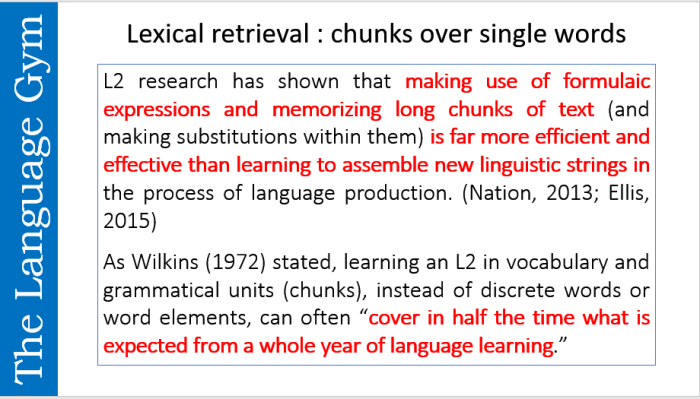
INTRODUCTION: TEACHING THROUGH CHUNKS
In the last few weeks I have been asked by many of my readers and colleagues on the Facebook professional group I founded (Global Innovative Language Teachers) the following questions:
(1) what I mean by teaching through chunks and patterns / constructions as opposed to single words and traditional grammar,
(2) where I get the chunks and patterns from and
(3) how I teach them.
Whilst I reserve to answer question (3) in a much more detailed post in the very near future outlining my MARS EARS sequence step by step, here I will deal with (1) and (2) as I know that many teachers are currently in the process of re-designing or tweaking their schemes of learning in preparation for the next academic year.
Here are the key principles of my curriculum design and classroom teaching.
2. LANGUAGE TEACHING SHOULD SERVE REAL WORLD COMMUNICATION
This is the bread and butter of Communicative Language Teaching. The teaching of lexis and grammar should serve communication, hence language learning should be about learning to perform real world communicative tasks through a range of high frequency L2 chunks and constructions.
Consequently, grammar should not be taught to novice-to-intermediate learners in futile abstract categories such as ‘Perfect tense’, ‘Imperfect tense’, or ‘Prepositions’; by the same token, vocabulary should not be selected randomly and taught through uncontextualized single words, based on a theme that means all and nothing, e.g. sports, house, holidays.
Our choice of the grammar and lexis we want to impart on our students should be driven instead by the communicative functions we believe are most important for our students to master in the real world.
But what do we mean by Communicative Functions (CF)?
In my latest professional development tour of England, I realised that the vast majority of England-based language teachers are not familiar with the concept. Here are some examples of key communicative functions:
– creating questions
– describing people
– describing places
– reporting an event in the past
– talking about the way one used to be
– talking about future plans
– comparing and contrasting
– expressing a purpose, etc.
A full list of CF, adapted from Finocchiaro and Brumfit (1983), one of many freely available on the internet, can be found here .
3. THE STARTING POINT: COMMUNICATIVE FUNCTIONS AND ‘THE MAJESTIC 12’
The starting point of any L2 curriculum design and teaching should be the communicative functions that one wants to cover by the end of the academic year, course, key stage 3 (i.e. years 7 to 9) or even key stage 4 (i.e. years 10 to 11).
Choose with your colleagues the top 20, 15 or 12 (depending on the time and resources available) functions that you believe your students MUST master by a specific stage in their L2-learning journey and decide how many you should teach each year and plan for their systematic recycling over the years. Remember: LESS IS MORE.
I usually choose 12 top Communicative Functions that I want my students to learn by the end of year 9, which I break down in micro-functions. I call them The Majestic 12.
Example of a macro-function: Describing people.
Examples of micro-functions: describing their character, describing their physical appearance, comparing and contrasting people, saying what the worst and best things about them are, etc.
If you were to choose your own Majestic 12, what would they be?
4. IDENTIFYING KEY PATTERNS AND CHUNKS
Once identified the CFs, you then identify the key patterns and chunks used most frequently to express them:
Example:
FUNCTION: Comparing and contrasting
PATTERNS AND CHUNKS:
X is more + adjective than Y
X is as + adjective as Y
Z is less + adjective than Y
Compared to X, Y is more + adjective
Teaching patterns is key. Without pattern recognition and activation students’ growth as L2 listeners, speakers, readers and writers is substantively stunted.
The Structural Deficit Hypothesis (SDH) attributes difficulties in the acquisition of reading to syntactic processing deficiencies (Bentin, Deutsch and Liberman, 1990; Menyuk et al., 1991; Scarborough, 1991). The SDH claims that an absence of syntactic knowledge or lack of processing ability interferes with higher level text comprehension.
MFL teachers in England often complain about their students using Google translator. However, if one doesn’t explicitly and systematically teach syntactic patterns, how can one expect their students to be able to string single words together grammatically and logically without help?
Take the list of subordinate clauses in Figure 1 below: how many of those do you explicitly teach and recycle over and over again from year 7 to year 11? When I ask this question in my workshops, only one or two participants put their hands up.
FIGURE 1 – List of key subordinate clauses in English
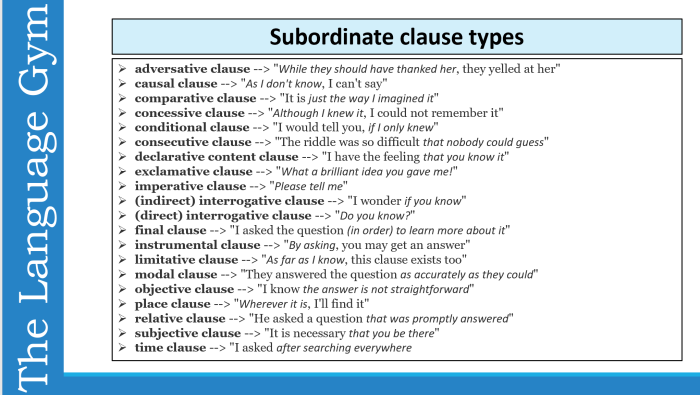
5. CHOOSING THE CONTEXT
At this stage you choose the context that best suits the teaching of that function in the launching phase and in the subsequent recycling phases. This is different from what is customarily done in my experience in English schools, where one usually chooses the context first (e.g. talking about hobbies) and then the target linguistic items (usually expressed in terms of words and grammar structures).
This is how I go about it:
Example:
FUNCTION: Comparing and contrasting
SUITABLE CONTEXTS
Talking about family (launching)
Talking about school subjects / teachers (recycling)
Talking about people I met during the holidays (recycling)
etc.
6.COMMUNICATION DRIVES THE TEACHING OF GRAMMAR
This way, communication drives your choice of the grammar and the theme. And when you share your objectives with your students, you will share a communicative purpose, e.g.: ‘Today we are going to learn how to talk about plans for the week-end. By the end of the lesson you will be able to understand the meaning of the patterns and vocabulary in this sentence builder (or any other knowledge organiser you may want to use) and some aspects of their usage.’
Similarly, when approaching the teaching of the imperfect tense in French, you will not teach all the seven rules of the imperfect – which overloads students and puts them off this tense; rather, it will be in one instance: ‘talking about how you and your family/friends used to be’ a function which will allow you to recycle time markers, adjectives, family members, adverbials, etc. killing several birds with one stone. In another instance: describing a past event (weather, places). In another instance still: describing what you were doing when something (e.g. an accident) happened. Each instance with its own contextualised chunks and patterns. Nothing wrong, of course, after coming across several instances of the Imperfect in pulling all the threads together and unifying them under the metalinguistic umbrella-term ‘the imperfect’.
When communication drives your selection of the grammar you teach, you don’t risk overloading your students with a myriad of rules and sub-rules and exceptions to them, that classic grammarians many centuries ago categorised under one convenient label (e.g. ‘Prepositions’, ‘Adverbs’, ‘Conditional’) artificially separating the inseparable: grammar from vocabulary.
Grammar and Lexis are too closely intertwined to be considered as distinct from one another: learning the word ‘beautiful’ in French (‘beau’) means learning its word-class, its word-order, its feminine and plural form, its grammatical attributes, not simply its meaning.
7. GRAMMAR LEARNING AFTER CHUNKS LEARNING – THE SEQUENCE MARS’ EARS
In my approach, grammar learning occurs organically after much exposure to and use of the target chunks and pattern through activities constantly recycling the same language over and over again (highly controlled input followed by highly controlled output).
Here is how a typical instructional sequence of mine (MARS’ EARS) unfolds over two or three lessons:
1.Modelling – this phase models the use of X number of chunks and patterns presented IN CONTEXT through sentence builders / story telling / songs / etc. My modelling tool par excellence are sentence builders such as the one in the picture below, because:
1. They are a great way to teach lexical and syntactic patterns in context;
2. They allow you to model chunks and patterns through listening and reading – reinforcing print to sound correspondence. You make and read aloud sentences, whilst the students translate them on mini white boards;
3. They are very clear and accessible knowledge organisers;
4. They help prevent agreement mistakes in languages like French, German, Spanish, Italian, etc. For instance, in the sentence builder below, clothes are taught together with the feminine or masculine form of the related adjective from the word go;
5. They help create a vocabulary-rich learning environment;
6. They can be used as a scaffold in students’ books or – as I do – constantly on the classroom screen as students interact orally;
7. They are a fantastic way to recycle old material and to plant the seed of new linguistic items you plan to teach in the near or distant future (implicit learning). Just put such items in a column of the sentence builder with the translation and they will be learnt effortlessly through exposure;
8. You can play many interactive games with them (e.g. sentence puzzles, guess what comes next, faulty echo, etc.)
9. Students love them – in every single student voice questionnaire I administered, the children rated them as the single most useful resource I gave them. Possibly because ‘they allow students to take ownership of their learning, resulting in active engagement early on’, as noted by my colleague Ursula Maley.
FIGURE 2 – sentence builders for a year 7 French class on describing clothes
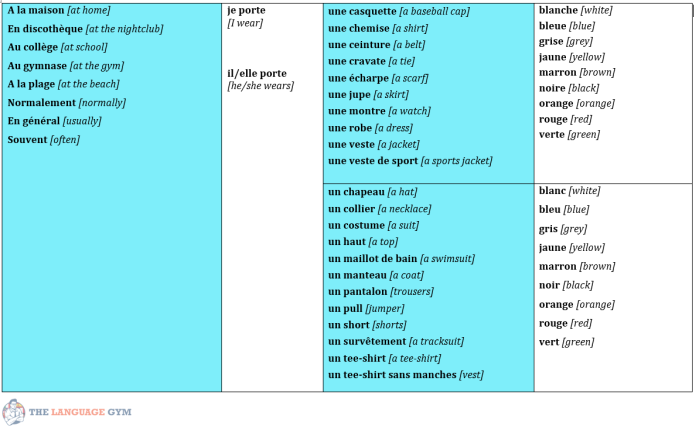
2.Awareness-raising – the learners are concisely sensitised to the patterns/rules governing the target chunks; their formation and use. This is not the typical lengthy explanation on a Power Point but rather ‘pop-up grammar’.
3. Receptive processing – provides high-intensity processing of enriched input practice through the receptive skills (Controlled Input). ‘Death by chunks’ through highly structured activities such as these fun read aloud games,(e.g. mind reading with prompts, sentence stealer, find someone who with cards, find your match) engaging narrow reading and listening tasks involving problems solving and thorough processing, sentence puzzles (e.g. the rock climbing game on http://www.language-gym.com or mosaic writing in FIGURES 3a and 3b), dictations, gapped parallel texts, etc. Every text is manufactured in order to be flooded with the same chunks and patterns over and over again and to contain 90 to 95 % comprehensible input. Scaffolding is available throughout (e.g. sentence builder on desks or classroom screen).
FIGURE 3a – Sentence puzzle (1): Mosaic writing
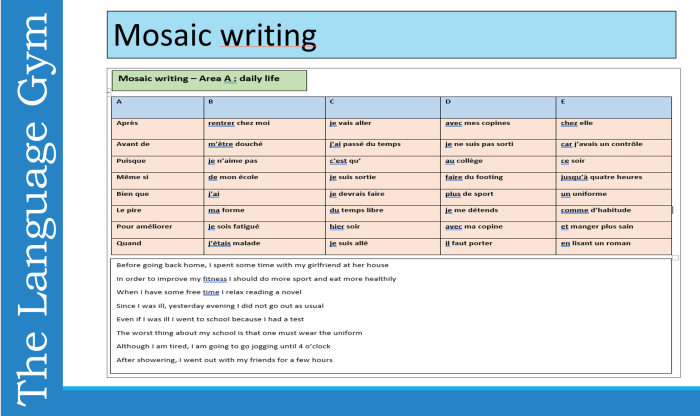
FIGURE 3b – Sentence puzzle (2) : rock-climbing game from http://www.language-gym.com
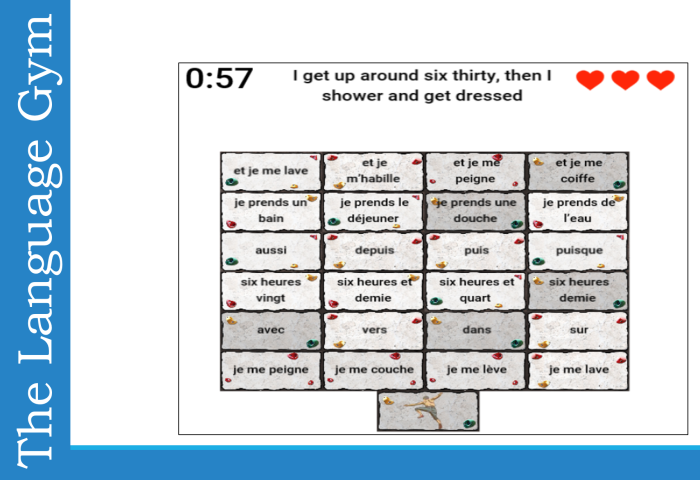
4. Structured production – provides intensive scaffolded and HIGHLY CONTROLLED production practice (Pushed Output). The chunks are now used in structured tasks. These include fun translation games, highly structured information-gap activities (see example in picture 6a and 6b below), Narrow translation, creative tasks (see example in picture 7), Interactional writing . Scaffolding is still available throughout.
Translation and other tasks that elicit highly controlled output are crucial at this stage, as you want your students to produce every single chunk you taught them, not simply come out with the same answer to a given question from year 7 to 11 (e.g. Q: ‘What did you do last week-end?’ A: ‘I played football, went to the cinema and ate pizza’). Pushed output tasks allow you to practise the production of as wide a range of target chunks as possible whilst recycling old material (Interleaving); this means you have total control over the output, something that traditional communicative tasks usually don’t allow.
FIGURE 4 – Oral translation board game – ‘No snakes no ladders’. The game is played in three, two players and a referee who has the solutions. When one mistake is made, the referee reads out the correct translation to the player who waits for his turn; if s/he gets it right the second time, s/he can cast the die and continue the race.

FIGURE 5 – Oral ping pong translation – two players challenging each other. Scoring: 3 points for 100% accurate sentence; 2 points if mostly accurate; 1 point if only verb is accurate.
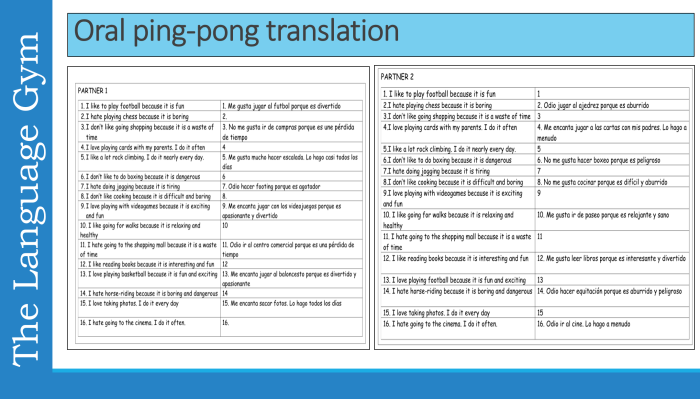
Figure 6a – A classic information-gap game – two detectives on different shifts are following the same person. They call each other and must fill in the details missing from their notes asking their partner.
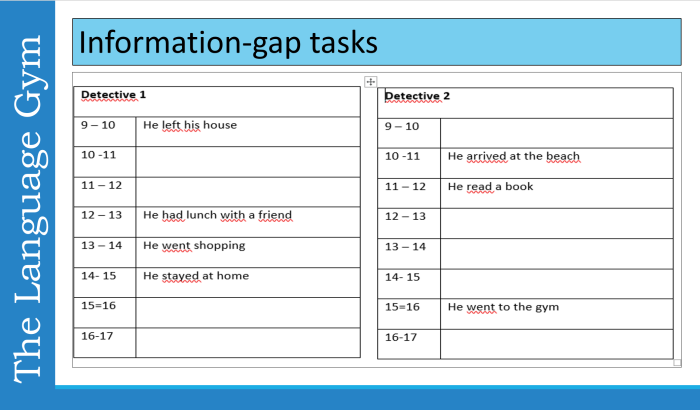
Figure 6b – An oral interaction scaffold designed to support a conversation on family. Questions are listed with a range of possible answers including the target chunks (translations provided)

.5. Expansion: two things happen in this phase:
(1) the target patterns/chunks are learnt in greater depth in order to teach the students how to make sense of the target patterns/constructions. This is your typical grammar lesson, except that it occurs after the students have already memorised the chunks and have been sensitised to the underlying grammar through relentless exposure and use .
Learning grammar by deconstructing the chunks one has already used over and over again is evidently much easier than learning it ex novo through decontextualized examples on a PowerPoint slide or textbook page.
(2) the target chunks are practised with old and new vocabulary and structures overtime through systematic recycling (INTERLEAVING). This is vital; since memory is context-dependent, learning the perfect tense within the topic ‘holidays’ doesn’t necessarily mean that it will be transferred automatically to other contexts.
Scaffolding may still be necessary during this phase.
6.Autonomy – This phase marks the end of each sub-unit in the Conti Matrix in figure 7. It is the phase in which you stage a set of low-stake assessments to verify the students are ready to move on to the next sub-unit and sets of items (in my approach: a new construction). The assessment will consist of two or three tasks, easy to mark and targeting mainly the receptive skills for the first three sub-units – you will move to the productive skills towards the end of the unit. I don’t usually tell my students there will be a test.
In essence, in this phase you want to find out if any scaffolding material (e.g. the sentence builders) can be phased out and the students are ready to stand on their own two feet. Do bear in mind that in the new MARSE cycle (beginning after this phase in the next sub-unit) you must keep recycling the material you have just covered (see the ticks in the Matrix below) as much as possible through constant retrieval practice across all four skills.
Figure 7 : The Conti Matrix for the planning of a unit of work (one term / trimester). Each unit of work is made up of five sub-units. In each of the first four sub-units you would stage a MARSE cycle for each new target item. In the last sub-unit, you will focus solely on fluency and spontaneity.
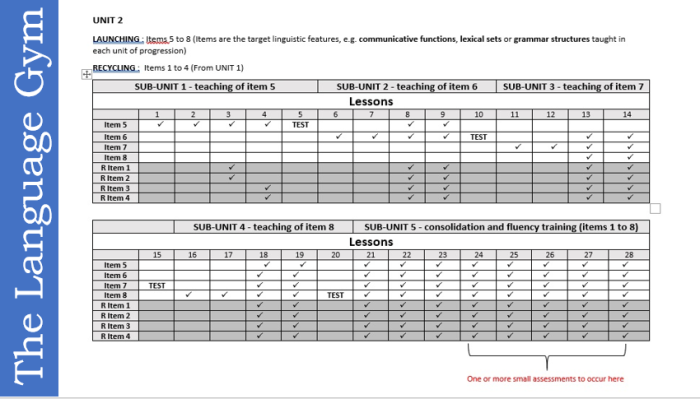
7.Routinization – focus is on recycling throughout the academic year and beyond through interleaving and fluency and automation-promoting activities. Some tasks simply recycle; others are designed to foster speed of retrieval and automatization (see 4,3,2 technique in picture 8, below). Other sample tasks here.
Figure 8 – the 4,3,2 technique
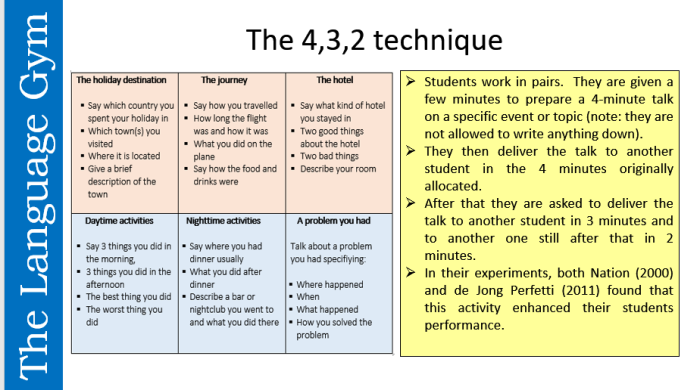
8. Spontaneity – This phase occurs at the end of a unit and continues throughout the subsequent units in the months and year to come, through deliberate and carefully planned recycling. It is the most important phase, as it is the phase you have been working for throughout the unit thus far: this is where all the things you have taught up to this point in the unit are put to use in the context of communicative tasks (see figure 9 for a definition of ‘task’).
Figure 9 – Definition of tasks (Nunan, 2015)
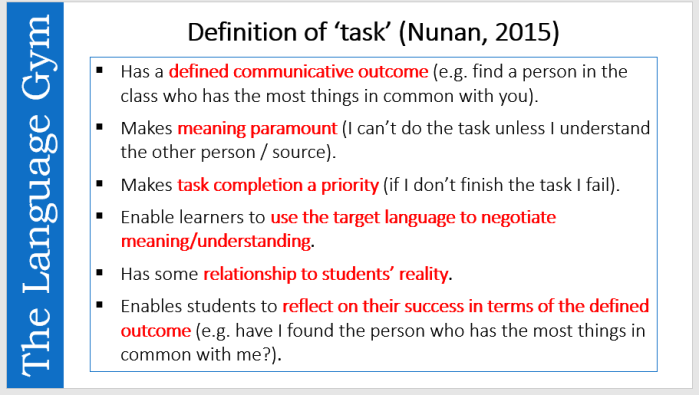
If you follow my unit-planning matrix (in figure 10, below), you will stage this phase in the final weeks of each term. You will possibly allocate to this phase 6-8 full lessons. This means doing away with the typical high-stake end-of-unit assessment that many departments in the UK stage at the end of a typical term. The rationale for this choice and how to implement it is explained in detail here.
Figure 10 – The Conti recycling matrix

I would normally stage two ‘rich’ communicative tasks which elicit the use of all the L2 items practised in the unit so far and the recycling of items learnt in previous units. The two tasks will be very similar in terms of the cognitive operations and procedures they involve, as well as in the type of language they require to be executed, in order for the second task to reinforce what was learnt in the previous one. They also integrate all four skills. The framework for the implementation of rich tasks is sketched out in figure 11 below.
Figure 11 – Framework for the implementation of a rich task
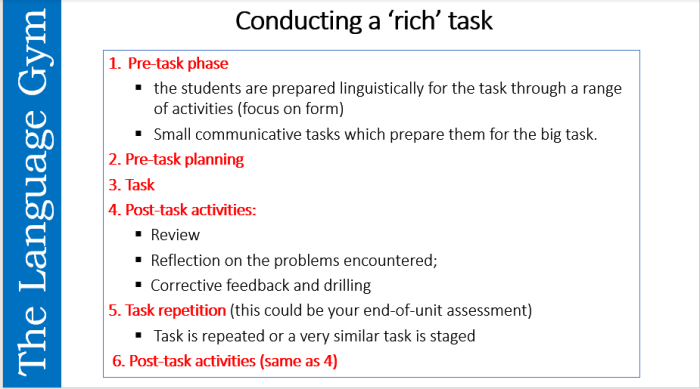
The first rich task is usually staged at the end of a series of smaller and less complex pre-tasks designed to activate prior knowledge and practise the structures and routines required by the richer task. These smaller tasks will include fairly straightforward “information-gap’, ‘opinion’ and ‘reasoning’ communicative tasks, role-plays and games such as the 4,3,2 technique, Messengers and Marketplace.
Each rich task is also preceded by a planning phase which involves (1) brainstorming of the language relevant to the task; (2) prediction of potential problem areas and (3) cooperative strategies such as ‘think, pair and share’. A post-task review involving feedback to the students on their (linguistic and non-linguistic) performance will follow both rich tasks.
Figure 12 – Type of tasks
Besides this task-supported phase, practice in unplanned response to a stimulus (a picture, a set of questions, a problem) is also provided at spaced intervals over the year to assess students’ ability to perform the target item(s) in the form of one or more termly teacher-student sessions. This is assessment for learning, not a traditional high-stake assessment. Students’ performance in these tasks is not graded; feedback is only positive, to foster willingness to talk.
Figure 13 – The MARS EARS pedagogic cycle

8. GRAMMAR MATTERS BUT IT IS TAUGHT AFTER A LOT OF PROCESSING OF CHUNKS
In sum, only after the students have learnt the patterns as vocabulary, as chunks, does the teacher actually explain the grammar rules that govern the use of the target constructions in order to enhance their generative power, i.e.: to enable the students to manipulate them creatively and spontaneously, at will. Or, even better, if you have the right students, you will ask them to inductively work out the rule by themselves – my favourite approach (see picture 9 below).
Figure 14- Inductive task on French negatives
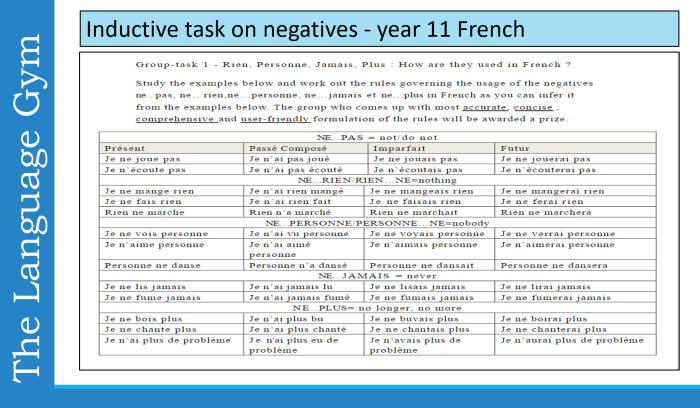
9. CONCLUSION – GRAMMAR VS LEXICOGRAMMAR
It will be obvious by now that I don’t teach grammar; not the traditional way at least. I teach chunks of language and constructions which convey a communicative function. Grammar is not necessary, but it is valuable in expanding the power of the chunks for future use, to enhance their expressive range and depth.
In other words I am teaching grammar through lexis and lexis through grammar – i.e. lexicogrammar.
This is a faster way to learn and activate what we traditionally call grammar and to help students get how grammar relates to real-world communication. Because ‘talking about how we used to be’ makes more sense to younger learners than the term ‘Imperfect’. Because learning through the ‘deconstruction’ of what one is familiar with already is easier than building from scratch. Because concrete, hands-on and contextualised information is easier to grasp than abstract notions presented in a vacuum.
It is worth reminding the reader that in my approach the content is reduced substantively compared to the norm (in my case from 6 to 3 units per year), as the main focus of instruction is not to accrue flimsy intellectual knowledge about the language or to memorise lists of words; rather, it is to bring about automaticity, fluency and spontaneity in the receptive and productive skills. However, the use of Implicit learning routines and other strategies discussed here , along with the vocabulary-rich environment you will have created through all the activities mentioned above, will eventually make up for the explicit content you cut out.
This goes beyond mere retention of information, hence it requires lots of recycling and tasks which foster speed of retrieval and execution. The aspirational goal being not having to re-teach in the years to come the same basic structures over and over again (as often happens !) and to forge student who can think in the L2 on the spot, with confidence and without much hesitation.




I have repeated, over and over again, to my students, and to language teachers in my workshops for over 35 years, that we learn to communicate in another language, as we do in our first language, my noting patterns, repeating them, and imitating them, with mistakes until we get it! We learn the general pattern first, then we learn to refine for the exceptions over time as we hear them modeled, as we read in the language to be acquired, and so on. I so appreciate your article, Gian Franco, as I have your many other articles. I have found a kindred spirit and a comrade in the trade in you, so I will look forward to part 2 when it comes out. Wishing you all the best! Grazie mille, e ciao!
Don
LikeLiked by 3 people
I am glad you agree with the content of my post and to have find a kindred spirit. I hope we meet in person. Best wishes !!! Ciao 🙂
LikeLike
Hi Gianfranco,
Just to let you know that we’ve shortlisted this blog post for this month’s TeachingEnglish blog award and I’ll be putting up a post about it on Saturday’s TeachingEnglish Facebook page http://www.facebook.com/TeachingEnglish.BritishCouncil, if you’d like to check there for comments.
Best,
Ann
LikeLiked by 2 people
Great ! Thank you Ann
LikeLike
A fantastic post. But something I’ve been wondering about the MARS sequence: as far as I can tell, you don’t make a hugely clear differentiation between modelling and receptive processing.
For example, in the modelling section you say that sentence builders “allow you to model chunks and patterns *through listening and reading* – reinforcing print to sound correspondence. You make and read aloud sentences, whilst the students translate them on mini white boards”. Is that not just the same as receptive processing?
I had a look, but couldn’t find any posts in your archive where you set out your blueprint for modelling.
LikeLike
Yes it is a form of receptive processing of course. I call it modelling to stress the fact that during this phase the teacher use this form of receptive processing to model
LikeLike
Hi! Could you be more specific on the rules of oral translation board game? What’s the procedure before dealing with mistakes? How do you use mosaic writing in class? How do sentence builders create vocabulary-rich environment?
LikeLiked by 1 person
Hi Natalya, the answer to question 1 in my blog post on translation games and techniques. Mosaic writing is used after much receptive practice, as a transition task from receptive practice to ‘proper’ writing: students are given sentences in English and they are asked to select the tiles which combined together result in their translation in the target language. Sentence builders like the one I create create vocabulary rich environment because they present a wider range of combinations of chunks than traditional single word lists, allow you to recycle old vocabulary alongside the new and model sentence production which can contain several chunks of language and two or more syntactic patterns.
LikeLike
Hi Gianfranco! Thank you for the answer. Am I right to understand that ( in this particular example) English is a foreign language, the language in the table is native, the sentences in the table are mixed and need to be unscrambled or matched? Could you give an example of what you revise in the sentence builder in the article and how is it rich ( let’s say “a white shirt” or I bought a white belt or whatever)?
LikeLike
No. French is the foreign language. The sentence builder is to present clothes with adjectives to beginner French students . Don’t understand the last question
LikeLike
Hello Gianfranco. Thanks for such inspiring material! I found this article really exciting as it makes so much sense, and made so many practical resource suggestions. I relied greatly on teaching patterns in language when I worked in EFL, and these resources really chimed with me. Currently, however, I am teaching French in a primary school where students have 50 minutes a week from the age of 5. It is taking me a long time to work out how to approach this! I have plenty of experience of the younger age-group, but not of such limited learning time. I am finding it really hard to do anything other than take the thematic approach and select a group of key vocabulary to target, then using it in a relevant sentence structure… it’s very limiting. While I make sure there is a functional goal and communicative activities form the bulk of the work, I would be really keen to hear how you might work to create a unit of 9 x 50 min lessons for early learners, using the approach you describe. I hope to make it to your Melbourne session in November, in which case I may be able to ask you in person! If not, I’d really appreciate anything you can offer here! Thank you.
LikeLiked by 1 person
[…] Hence, model useful, high-frequency ready-made chunks for students to memorize; give them masses of opportunities to process those chunks receptively (through listening and reading through 95 % comprehensible input) and then produce them in feasible input. This will speed up the onset of fluency because anyone can memorize and recall multi-word chunks, but only a few gifted beginners can piece words together applying grammar rules on the spot -‘online’ – successfully. Read this if you are interested in finding out how I suggest this can be done. […]
LikeLike
Hi Gianfranco,
As a trainee MFL teacher, I can’t thank you enough for this wonderfully helpful post. After floundering about with text books, suddenly, it all makes sense!
LikeLike
[…] my own experience and the success of my students, within the context of Dr Gianfranco Conti’s MARS EARS teaching methodology. I had been creating, using and experimenting with Sentence Builders as a […]
LikeLike
[…] may increase as teachers seek “solutions” to the Covid-19 catch-up problem. Conti’s “Extensive Processing Instruction (EPI)” is a likely candidate. Conti draws explicitly on approaches from the 1980s which promised, like […]
LikeLike
There are some major inaccuracies in the post in which you have referenced my approach, the most notable of which: (1) nobody advocates for the teaching of decontextualised chunks; (2) I advocate for the teaching of phonics, vocabulary and grammar, not the mere “memorization” of chunks. The authors of this article don’t fully understand EPI.
LikeLike
[…] Builders book, and asked if we could translate it into Welsh, as we were all very interested in the Extensive Processing Instruction (E.P.I) approach developed by Dr Gianfranco Conti. To our delight, the amazing Gianfranco and Dylan […]
LikeLike